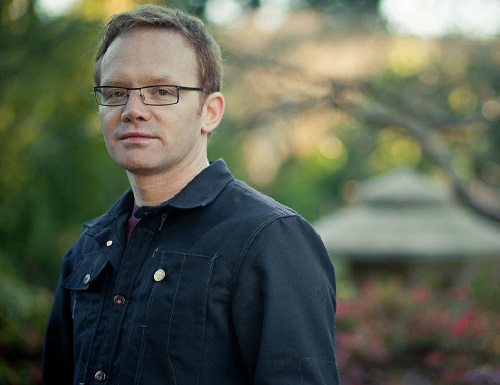- How Does Thor Muller, Founder of Get Satisfaction Think Online Complaints Should Be Handled?
- What Is The Relationship Between Online Complaint Sites And Google?
- How Should Scientific Innovation Be Funded?
Full Interview Audio

Personal Info
Sports Teams:Jamaica bobsled team, Utah Jazz
Most Influenced By:Marc Andreesen, EV Williams, Richard Feynman
Twitter: http://twitter.com/tempo
Personal Blog: http://blog.getsatisfaction.com/home
Website: http://getsatisfaction.com
Relevant Link: http://origin.al
Interview Highlights
This is a condensed, lightly edited transcript of an audio interview. The full audio is available and highly recommended. The interviewee may post clarifications in the comments.
Adrian Bye: Today we are here with Thor Muller who is cofounder of Get Satisfaction and generally a smart guy out in Silicon Valley. Thor thanks for joining us and tell us a little bit about yourself.
Thor Muller: Thanks for having me. I have been doing this Internet entrepreneur thing since the mid-90s, largely by necessity since I have tended to be a little bit ahead of the market. A lot of times people think of being ahead of the market is such a wonderful thing but all the people I know who have gotten the richest have been a little behind the market.
My first business was early web development. I proceeded from there to start a software business in 99, and learned what it meant to sell your soul to the devil which I wouldn’t recommend.
Adrian Bye: What do you mean by selling your soul to the devil?
Thor Muller: I mean saying what other people want to hear and doing what they want to buy, as opposed to what you believe is actually a useful meaningful product that has long-term legs. In that particular case I had an idea that the future of the web wasn’t going to be simply about building websites but about distributing content that was going to enable smaller vendors to reach larger audiences. I think the pattern has clearly been proven correct.
The good thing about Silicon Valley is that it is pretty good at disrupting itself. The Sand Hill Road dominant approach of iterating an early business has given way over the years to one which is much more entrepreneurial friendly and more open to radical new approaches.
We felt that the Web 2.0 patterns had great utility within businesses to solve the intractable business problems like customer service. Everybody hated customer service; it was a cost center and drove customers crazy.
It seemed to us back then that it was crazy that marketers would spend millions and millions of dollars to engage with people, but when customers were at their most naturally engaged the companies essentially build these walls in front of their businesses. We build Get Satisfaction as a way to tear down those walls and bring people and companies closer together. We were pioneers in that space, and Get Satisfaction is continuing to go strong today.
Adrian Bye: What do you think about the Ripoff Report?
Thor Muller: The idea of Get Satisfaction started with the idea that customers wanted a more open conversational approach to dealing with companies; that blogs and social networks were a natural fit for customer service needs. Our first version of the product was essentially just a customer support community app for businesses with a 37signal-style sales model.
What we realized was that people had lots of complaints and no good place to put them. Twitter had not emerged yet as a mainstream phenomenon, Facebook was still just for colleges, so we said let’s launch as an open customer service community where anybody who had an issue can post it about any company.
It was people asking questions, reporting problems, sharing ideas around companies. Sometimes these would be very positive in nature. Timbuk2, the bag manufacturer, people would go on there and they would brainstorm about how they would improve the products and rave about new designs that have come out. Sometimes they would be very negative like Comcast.
We gained a lot by empowering the customer to be in charge of this conversation. We realized that it was easy for a few squeaky wheels to hijack the conversation. There was the promise of what we were talking about – a more transparent, human oriented business or customer experience – and then there was the reality of an asymmetric power for not just individuals but certain individuals with a lot more time on their hands and a lot more anger. That I think in a nutshell is the path that Get Satisfaction has been on for a long time – how do you balance those two sides?
One of the things we did is created this idea of champions. One of the classic ways you enable people to take more responsibility for social mores within a space is you give them a little bit of power.
The second area you focus on is empowering organizations or people within organizations. We rolled out our paid plans which came attached with moderation tools. That was a hard shift for the company to make because we created the company to be very values-based. Some of the employees were saying if we allow companies to delete posts by customers, then we are essentially allowing censorship and there is no transparency to that. Our solution to that was to come up with a change log, so that a company could delete those posts but the fact that they had made this deletion would be available for others to see.
Adrian Bye: I think in this category Ripoff Report is one of the most interesting. Their business model is collect lots of complaints and you can pay quite a lot of money and then get the complaints removed. I have heard numbers of something like a quarter of a million dollars to be suddenly a reformed business and a good corporate citizen. What are your thoughts on that?
Thor Muller: Collecting complaints with the business model of allowing companies to remove those complaints if they pay enough is a nasty business. Yelp at one point was accused of doing something similar. I just don’t think that it is a business that I would want to personally be associated with. I don’t know if that is what they are doing, but a Consumer Reports style business which is more crowd-based is an awesome idea. If that is what they are doing then all the better.
Adrian Bye: What do you think about the relationship then between Google and sites like Get Satisfaction and Ripoff Report? 
Thor Muller: There was a situation two years ago where this guy who sold sunglasses online bragged to the New York Times that he cultivated bad reviews because they actually improved his SEO. As you can imagine this was not something that we thought was a good idea. A lot of this has to do with how Google ranks these types of things.
I do think that because most visits to these kinds of sites go through Google. Google have to know sentiment and they have to take that into account and understand reputation, which they already due to some extent.
It is very difficult for them to know the difference between an expos? of a bad product and a squeaky wheel. On the one hand there are the responsibilities of these systems, whether it is Get Satisfaction with its social design and tools for moderating healthy and honest communities. There is the system design of Google, who has to figure out what to present for a given search. But there is also culture; there is the way that individuals and companies change over time.
15 years ago the MO for a company was if something bad happens, to go into classic PR damage control mode. Today more and more companies say “We are hearing this issue it is a real issue and we are working on fixing it, send us information.”
It’s an interesting challenge when honesty becomes commoditized. Now we are just saying there is some trick to it, honesty can be an artifice. The question is, is it better to have honesty as an artifice than not have honesty at all? Or is there a way to differentiate between shallow honesty and deep honesty? These are deep questions and I don’t have the answer to them.
Hopefully one of the benefits is that we are moving to a world where personal and professional reputations are much more intertwined and so as a result we are much more accountable to our behaviors in the marketplace. There is evidence on both sides of this one but I hope that we keep working towards that accountability because I don’t think that the earth can take a tremendous amount more of not thinking about the long-term implications of what we are doing especially when it comes to our footprint in the natural world.
Adrian Bye: What you are doing with Get Satisfaction, was it a fun business to work on? Because you are dealing with such intensity of problems.
Thor Muller: What was exciting about Get Satisfaction was approaching the side of rewiring of this relationship between companies and customers. It was fun for as long as that was the primary thing we were doing, but for me now as we began to get more into scaling up software as a service business that was less fun for me.
There is a big difference between going into an open space that is really undefined, figuring out what the natural grain of the problem is and building solutions that are scalable. I thrive in those kinds of environments, so I am naturally comfortable in undefined problem spaces. That is where Get Satisfaction was for the first not just one or two years but probably three or four years. 
After that it gets into an incremental turning of the crank in the business. Obviously great businesses reinvent themselves; they find new problem areas to explore. I am sure Get Satisfaction will do that but I found myself less interested in the space the more it became a known and quantified problem area.
Adrian Bye: What categories do you notice more complaints in in general?
Thor Muller: Bigger companies. If they are a big corporation people are assuming that you are going to screw them. It is a defensive crouch versus an open engagement of perspective. Smaller companies are more likely to get suggestions, whereas bigger companies are more likely to see lots of problems.
I think this is one of the reasons why cable companies and telecom companies have such high frustration rates. At companies like Apple, one of the reasons why they have historically had really high customer service ratings is because they have focused so much on simplicity.
Adrian Bye: Tell us a little bit about your next business, Original.
Thor Muller: The short description is that we are going to make a place for people to demonstrate, discover and develop professional skills. The things that have traditionally mattered like going to the right schools, staying in positions in companies for periods; are no longer the default for people. It has never been more important for people to be empowered to manage their own trajectory.
Right now we are focused on individuals; on giving them the ability to represent themselves and their work, and comingle with others that are on similar paths, then making this available to organizations.
We think that when we talk to people that do a lot of hiring, they are using tools like Github more to accelerate their hiring process. If they are hiring a developer, to be able to see the code that somebody has worked on is really valuable.
Other tools that people use in this space are Behance which Adobe just bought for designers to present their creative work. We have basically one dominant app in this area and that’s LinkedIn; and meanwhile the space is changing at an accelerating rate.
Right now I am playing around with Coursera for instance and we are looking at how we can leverage graph visualizations. If you are directed, there has never been more information out there, and the question is how can we help people feel not so overwhelmed? There may be more information out there but that is really getting harder and harder for people to deal with.
Adrian Bye: In an unrelated but interesting to me topic, tell me what you think about science funding? Just as a back story, I have been arguing with Thor about this on Twitter and we had about 50 tweets pummeling each other on this topic, so I am interested to hear your thoughts verbally.
Thor Muller: The reason why I took a strong stand on this is because I have a good friend who is the head of research at a cancer lab and he has been telling me for some time now about how the landscape has changed for long-term cancer research, and about how his job which used to be 15% of his time going on finding grants to fund his lab is now over 50%.
The impact is felt with his ability to hire younger researchers who would better be on a track to have their own long-term research and have groundbreaking research. That loss of demand by these research labs is being taken up by commercial entities – biotech, pharma and so on.
While a lot of these companies work on important things, they often historically have relied on the public long-term research. He was really concerned by that and it made a lot of sense to me. When we talk about cutting NIH budget by 5%, the impact that represents is potentially much greater than it appears.
Adrian Bye: I believe science funding should be focusing on two things: doing the megaprojects like the Genome Project and this brain mapping project. Then I think we should be focusing on serendipity, because all these big Nobel prize winners more often than not stumble on things. I would say we should be doing megaprojects and then looking for things a little bit like Y Combinator but for science.
Thor Muller: I think that it is kind of almost a Platonic ideal. I guess where I come in is that I think there is a level of reality which we have to bridge the gap between the Platonic ideal and what we see in the world. But let me take your points one by one.
Last year I published a book called “Get Lucky” which is subtitled “How to put planned serendipity to work for you in your business.” I am a huge believer in what you are saying about serendipity.
Most of the good stuff that happens is not blind luck. You have to be able to recognize novelty. You have to be able to put the pieces together. That is where training comes in.
I think that the benefit of some of the long-term public research projects beyond aiming for the moon shots is to create space for people to not have the pressure to perform against the plan. The best organizations designed themselves to take advantage of those discoveries. An example would be 3M which was able to take advantage of the discovery of the weak adhesive which became the Post-it note.
Adrian Bye: Thor is there anything else you want to add before we wrap up?
Thor Muller: That’s it I really enjoyed the conversation. I wish you and your audience the best.
Adrian Bye: Thanks very much for the interview.









